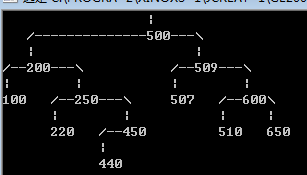显示二叉树
题目描述
排序二叉树的特征是:
某个节点的左子树的所有节点值都不大于本节点值。
某个节点的右子树的所有节点值都不小于本节点值。
为了能形象地观察二叉树的建立过程,小明写了一段程序来显示出二叉树的结构来。
class BiTree
{
private int v;
private BiTree l;
private BiTree r;
public BiTree(int v){
this.v = v;
}
public void add(BiTree the){
if(the.v < v){
if(l==null) l = the;
else l.add(the);
}
else{
if(r==null) r = the;
else r.add(the);
}
}
public int getHeight(){
int h = 2;
int hl = l==null? 0 : l.getHeight();
int hr = r==null? 0 : r.getHeight();
return h + Math.max(hl,hr);
}
public int getWidth(){
int w = (""+v).length();
if(l!=null) w += l.getWidth();
if(r!=null) w += r.getWidth();
return w;
}
public void show(){
char[][] buf = new char[getHeight()][getWidth()];
printInBuf(buf, 0, 0);
showBuf(buf);
}
private void showBuf(char[][] x){
for(int i=0; i<x.length; i++){
for(int j=0; j<x[i].length; j++)
System.out.print(x[i][j]==0? ' ':x[i][j]);
System.out.println();
}
}
private void printInBuf(char[][] buf, int x, int y){
String sv = "" + v;
int p1 = l==null? x : l.getRootPos(x);
int p2 = getRootPos(x);
int p3 = r==null? p2 : r.getRootPos(p2+sv.length());
buf[y][p2] = '|';
for(int i=p1; i<=p3; i++) buf[y+1][i]='-';
for(int i=0; i<sv.length(); i++) ________________________________; //填空位置
if(p1<p2) buf[y+1][p1] = '/';
if(p3>p2) buf[y+1][p3] = '\';
if(l!=null) l.printInBuf(buf,x,y+2);
if(r!=null) r.printInBuf(buf,p2+sv.length(),y+2);
}
private int getRootPos(int x){
return l==null? x : x + l.getWidth();
}
}
public class Main
{
public static void main(String[] args)
{
BiTree tree = new BiTree(500);
tree.add(new BiTree(200));
tree.add(new BiTree(509));
tree.add(new BiTree(100));
tree.add(new BiTree(250));
tree.add(new BiTree(507));
tree.add(new BiTree(600));
tree.add(new BiTree(650));
tree.add(new BiTree(450));
tree.add(new BiTree(510));
tree.add(new BiTree(440));
tree.add(new BiTree(220));
tree.show();
}
}
对于上边的测试数据,应该显示出:
|
/--------------500---
| |
/--200--- /--509---
| | | |
100 /--250--- 507 /--600
| | | |
220 /--450 510 650
|
440
(如有对齐问题,请参考【图1.png】)
请分析程序逻辑,填写划线部分缺失的代码。
注意,只填写缺少的部分,不要填写已有的代码或符号,也不要加任何说明文字。

// 先把要填代码的那行注释,运行一下,根据结果就知道buf第一个索引是y+1,并且是要将sv这个字符串填到buf中,然后第二个呢,试出来的哈哈哈
buf[y + 1][p2+i] = sv.charAt(i);
